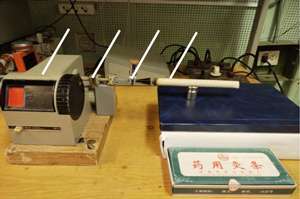Microwave parameters investigation of moxa wormwood cigarette
DOI:
https://doi.org/10.3103/S0735272722100053Abstract
The investigation results of microwave parameters of moxa thermal state for jiu therapy are presented in the article. The theoretical and physical foundations of research are described. The information about moxa of different composition and manufacturers is presented. The characteristics and description of the unique radiometric equipment and research methodology are given. As a result of experimental measurements, it becomes clear that smoldering moxa cigarettes generate not only infrared, but microwave radiation also. At the same time, the microwave signal level is almost 100 times higher than the human radiation level, which creates an additional therapeutic effect. It is established that cigarettes of different brands and with different additional fillings have the same radiation level. In addition, the radiation power in the millimeter range does not change during the research, while the infrared radiation power decreases during the same time. The obtained results allow us to assert the possible complex effect of thermal and microwave components of the wormwood cigarette (moxa) on a patient. The operational mechanism of the entire radiation spectrum of smoldering moxa requires a deeper research, from the point of view of evidence-based medicine in medical practice.
References
- H. Deng, X. Shen, “The mechanism of moxibustion: ancient theory and modern research,” Evidence-Based Complement. Altern. Med., vol. 2013, pp. 1–7, 2013, doi: https://doi.org/10.1155/2013/379291.
- C. Qian, J. Qian, Y. Bai, “Development of near-infrared-moxibustion simulator and its clinical curative effect,” Hongwai Jishu, vol. 13, no. 6, pp. 27–32, 1991.
- T. Zhang, Some Heat Issues of the Moxibustion Therapy. Henan Traditional Chinese Medicine, 1988.
- G. Wang, L. Zhang, W. Zhang, “Combustion characteristics of moxa stick,” J. Chinese Med. Mater., vol. 23, no. 9, pp. 569–570, 2000.
- W. Hua, Zhenjiuxue. Beijing: Hongguo Medicine Press, 2012.
- N. A. Struev, “History of chiu-therapy among theindigenous Peoples of the far north,” Reflexology Complement. Med., vol. 31, no. 1, pp. 39–42, 2020.
- H. Fröhlich, “Long-range coherence and energy storage in biological systems,” Int. J. Quantum Chem., vol. 2, no. 5, pp. 641–649, 1968, doi: https://doi.org/10.1002/qua.560020505.
- S. P. Sitko, L. N. Mkrtchyan, Introduction to Quantum Medicine, [in Russian]. Kiev: Pattern, 1994.
- N. D. Devyatkov, M. B. Golant, O. V. Betskiy, Millimeter Waves and Their Role in Life Processes, [in Russian]. Moscow: Radio i Svyaz’, 1991.
- O. Yanenko, “Low-intensive microwave signals in biology and medicine,” J. Hum. Physiol., vol. 1, no. 1, pp. 29–41, 2019, doi: https://doi.org/10.30564/jhp.v1i1.1453.
- A. F. Yanenko, S. N. Peregudov, I. V. Fedotova, O. D. Golovchanska, “Eguipment and technologies of low intensity millimeter therapy,” Visnyk NTUU KPI Seriia - Radiotekhnika Radioaparatobuduvannia, no. 59, pp. 103–110, 2014, doi: https://doi.org/10.20535/RADAP.2014.59.103-110.
- O. T. Morozova, V. I. Zdybsky, S. S. Shcherbakov, History of Chinese Medicine. The Path from Legends to Science, [in Russian]. Kharkov: Esin, 2018.
- Ukrainian Center for Standardization and Metrology, “Certificate of State Metrological Attestation ‘Measurement installation for small power levels of millimeter wave range NU-2’ No. 26-008,” Kharkiv, 2000.
- O. P. Yanenko, K. L. Shevchenko, V. M. Kychak, Methods and Means of Formation, Processing and Use of Low-intensity Electromagnetic Signals. Vinnytsia: VNTU, 2020, uri: https://press.vntu.edu.ua/index.php/vntu/catalog/book/598.
- S. P. Sitko, Y. A. Skrypnik, A. F. Yanenko, Hardware Support of Modern Technologies for Quantum Medicine, [in Russian]. Kiev: FADA, 1999.
- S. E. Hollow, T. C. Johnstone, “Realgar and arsenene nanomaterials as arsenic-based anticancer agents,” Curr. Opin. Chem. Biol., vol. 72, p. 102229, 2023, doi: https://doi.org/10.1016/j.cbpa.2022.102229.


